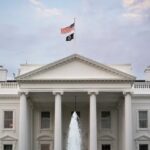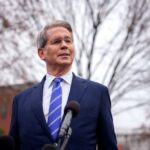By Tom Ozimek
The Federal Reserve’s interest rate-setting body decided Wednesday to keep the benchmark Federal Funds target rate unchanged within the 1.5 to 1.75 percent range.
Members of the Federal Open Market Committee (FOMC) met on Jan. 28-29 to consider economic data before issuing a policy decision on an interest rate hold, cut, or hike.
Citing labor market strength, in particular solid job gains and low unemployment, as well as economic activity that “has been rising at a moderate rate,” participants decided to keep rates steady.
“The Committee judges that the current stance of monetary policy is appropriate to support sustained expansion of economic activity, strong labor market conditions, and inflation returning to the Committee’s symmetric 2 percent objective,” the FOMC said in a statement.
Still, the Committee expressed some concern that inflation remained muted.
“On a 12‑month basis, overall inflation and inflation for items other than food and energy are running below 2 percent,” the FOMC said.
“Market-based measures of inflation compensation remain low; survey-based measures of longer-term inflation expectations are little changed,” the Committee noted.
One of the market-based inflation expectations measures the Fed considers shows that market participants believe average inflation over the next 10 years will hover around 1.7 percent.
At its prior meeting in December, the FOMC voted to keep the benchmark interest rate similarly unchanged. But at three earlier meetings in 2019, spurred by economic headwinds, committee members slashed the target federal funds rate by a quarter percentage point each time.
Repo Operations
The Fed did not give new guidance about its current practice of buying $60 billion U.S. Treasury bills monthly to ensure adequate short-term liquidity in bank funding markets. That program will remain in place at least into April, while a related offering of repurchase agreements (repo) will continue at least through April.
In an implementation note, the FOMC justified continued repo operations on grounds of ensuring “that the supply of reserves remains ample even during periods of sharp increases in non-reserve liabilities, and to mitigate the risk of money market pressures that could adversely affect policy implementation.”
The Fed added it would limit the term and overnight repurchase agreement operations to a per-counterparty limit of $30 billion per day.
‘Unhealthy Dynamic’
The Fed has been wary of allowing inflation to run too cool, afraid of pushing the public’s price growth expectations lower and landing in a Japan-like zone of persistent economic stagnation.
“While low and stable inflation is certainly a good thing, inflation that runs persistently below our objective can lead to an unhealthy dynamic in which longer-term inflation expectations drift down, pulling actual inflation even lower,” Fed Chairman Jerome Powell said in a statement after the FOMC meeting concluded on Wednesday (pdf).
He added that persistently sub-target inflation would hold interest rates down, and as a result “the scope for interest rate reductions to support the economy in a future downturn would be diminished, resulting in worse economic outcomes for American families and businesses.”
Powell expressed dissatisfaction that “inflation continues to run below our symmetric 2 percent objective” and suggested the Fed would do what it takes to prevent stubbornly below-target inflation.
“We’re strongly committed to achieving our symmetric 2 percent inflation goal,” Powell insisted.
The FOMC’s decision to maintain the current level of rates was in line with the expectations of experts interviewed by The Epoch Times.
“I believe there will be no change in the benchmark rate and essentially no changes in the Fed statements compared to those released after the last Fed meeting,” said Robert R. Johnson, Professor of Finance at Heider College of Business, Creighton University.
“The Fed is on hold with interest rates until they’re compelled to act further,” said Greg McBride, Senior Vice President and Chief Financial Analyst at Bankrate. “Realistically, as long as economic growth holds near 2 percent the Fed could be on the sidelines throughout 2020.”
“The FOMC is likely to stay on hold because economic data has not changed materially since last month’s meeting,” said Allen Sukholitsky, Founder and Chief Macro Strategist at Xallarap Advisory, in a statement to The Epoch Times. “However, investors should note that, as of today, the market is pricing in a greater likelihood of two cuts than no cuts, by next December’s meeting.”
“Our base case is for two cuts this year, with a higher probability of three cuts than one cut,” Sukholitsky added.
“According to the CME’s Fed Watch Tool, there is an 89.5 percent chance that rates will remain unchanged and a 10.5 percent chance that the Fed will announce a quarter-point rate hike,” Johnson added, adding the caveat that the turbulence caused by the coronavirus outbreak likely dampened FOMC enthusiasm for a rate hike.
Future Rate Expectations
Regarding future rate decisions, the FOMC said it would be driven by incoming economic data “including global developments and inflation pressures.”
Nicholas Reece, senior financial analyst and portfolio manager at Merk Investments, compiles detailed Fed Reports (pdf) in which he tracks data that he believes Fed officials—and Fed Chairman Jerome Powell in particular—are most focused on in determining policy in line with the central bank’s dual mandate of price stability and maximum employment.
These measures include the Fed’s estimate of the so-called “natural real rate of interest,” as well as various employment data sets—including the U-3, U-5, and U-6 unemployment rates—and the “Phillips Curve,” which shows the relationship between the unemployment rate and wages.
Commenting on the ramifications of the current shape of the Phillips Curve, Reece pointed to subdued wage inflation, saying: “I think in Powell’s mind that suggests the labor market might not be at maximum employment yet.”
In a press conference following the FOMC meeting Wednesday, Powell discussed the unusual wage dynamics.
“If you go back 4 or 5 years, the 4 or 5 major wage statistics that we track were running at around 2 percent and now they’re running at around 3 percent, which is theoretically about where they might be around full employment, consisting of inflation plus productivity growth,” Powell said. “It’s a bit surprising that with sustained levels of historically low unemployment we haven’t seen wages move up above that level as we have in other long expansions and other periods of low unemployment.”
Powell said what could be causing muted wage pressure is that the natural rate of unemployment is lower than previously believed, and another is the supply-side shock of people entering the labor market.
“It’s a great thing, it’s a very healthy thing,” Powell said. “We’re a country that has low labor force participation compared to essentially all of our advanced economy peers and it’s a very positive thing. Nonetheless, it represents more labor supply and it may be holding down wages.”
“Market expectations of the Fed funds rate in one year have come down since the Fed’s last meeting,” Reece told The Epoch Times in a statement. “The market is pricing the Fed Funds rate in one year at 1.26 percent, which implies about one rate cut over the coming twelve months.”
He said a likely trigger for a future rate cut would be significant downward pressure on Treasury yields. Falling yields could be caused by flows out of equity markets and into bonds as investors react to deteriorating economic conditions and flee to safe-haven assets.
“If the 10 yr yield falls below 1.50 percent, a rate cut becomes very likely,” Reece explained.
A rate hike, on the other hand, would become less likely in the event of the yield surging above 2 percent. A dynamic like this could be caused by investors feeling confident about continued economic expansion and leaving bonds in favor of equities.
“I would guess that a hike from the current level is unlikely unless and until the 10yr yield is above 2.0 percent for a sustained period given that the Fed doesn’t want an inverted yield curve,” Reece noted.
Further, Reece shared a graph with The Epoch Times showing the Fed’s so-called “Dot Plot,” which represents FOMC participants’ assessments of appropriate monetary policy.
“The market pricing, represented by the Fed Funds Futures (grey line) is substantially below the median dots for year-end 2020 and 2021, and reflects the expectation for more rate cuts,” he explained.
Reece noted, however, that it’s not uncommon for the Fed to punctuate hiking cycles with periods of rate cuts.
“For example, the Fed cut rates three times in 1998, and then resumed hikes to the rate cycle peak in 2000,” he said.
“Resumed rate hikes in this economic expansion are not out of the question,” he concluded.






